This post may contain affiliate links. For more information, please see our affiliate policy.
Learn how to brine a turkey with the dry-brine method for the most flavorful, succulent bird with the crispiest, crackliest skin ever. Instructions for wet brining are included, too.
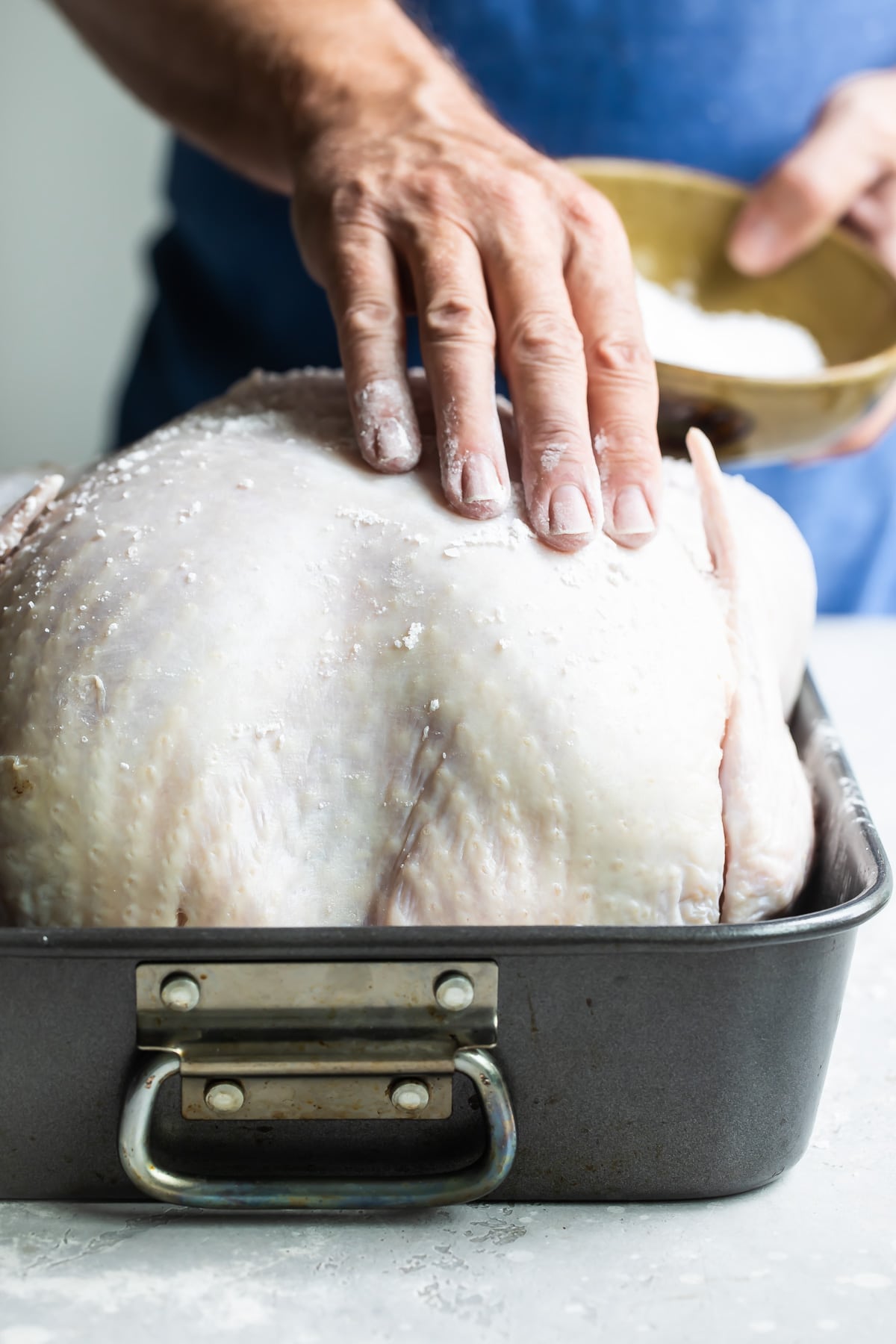
Forget the big heavy tub and sloshy salt water! The secret to a juicy, never-dry turkey is dry brining, aka pre-salting. The salt draws out the extra moisture in the turkey, forms a salt solution on the outer layer of the bird, and then is reabsorbed back into the meat to season it.
But all you have to know is how to do it. It’s the easiest thing in the world, even if you’ve never roasted a turkey in your life. No special equipment, magical ability, or giant bucket is required. Just make sure you have a thawed turkey and a day or so to let the brine do the work.
Table of Contents
Recipe ingredients
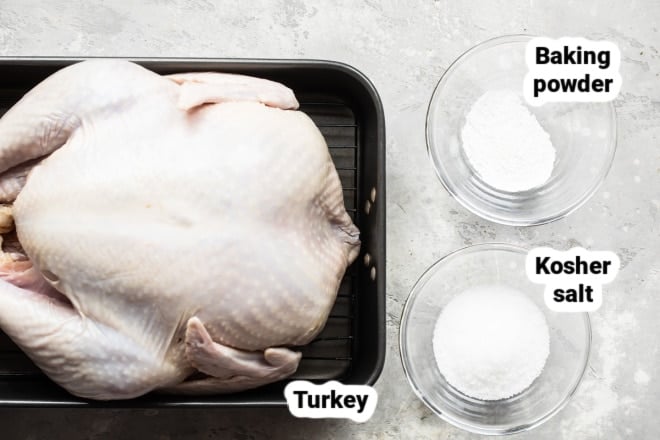
At a Glance: Here is a quick snapshot of what ingredients are in this recipe.
Please see the recipe card below for specific quantities.
Ingredient notes
- Turkey: Look for a natural or heritage turkey with the words “no salt added” on the label. Stay away from “self-basting” or Kosher turkeys which are injected with a salt solution. Brining an already salted turkey will make the bird way too salty. How much turkey per person? Plan on 1 1/4- 1 ½ pounds for each eater.
- Kosher salt: Kosher salt is iodine-free with a coarse texture ideal for rubbing on meat (Morton’s and Diamond Crystal are good brands). Don’t substitute standard table salt here; it’s finer and saltier than kosher.
- Baking powder: Baking powder dries out the outer layer of the turkey resulting in deliciously crispy skin.
Step-by-step instructions
- Under running cold water, rinse the turkey well inside and out. Remove any excess fat or pin feathers. Pat dry using paper towels.
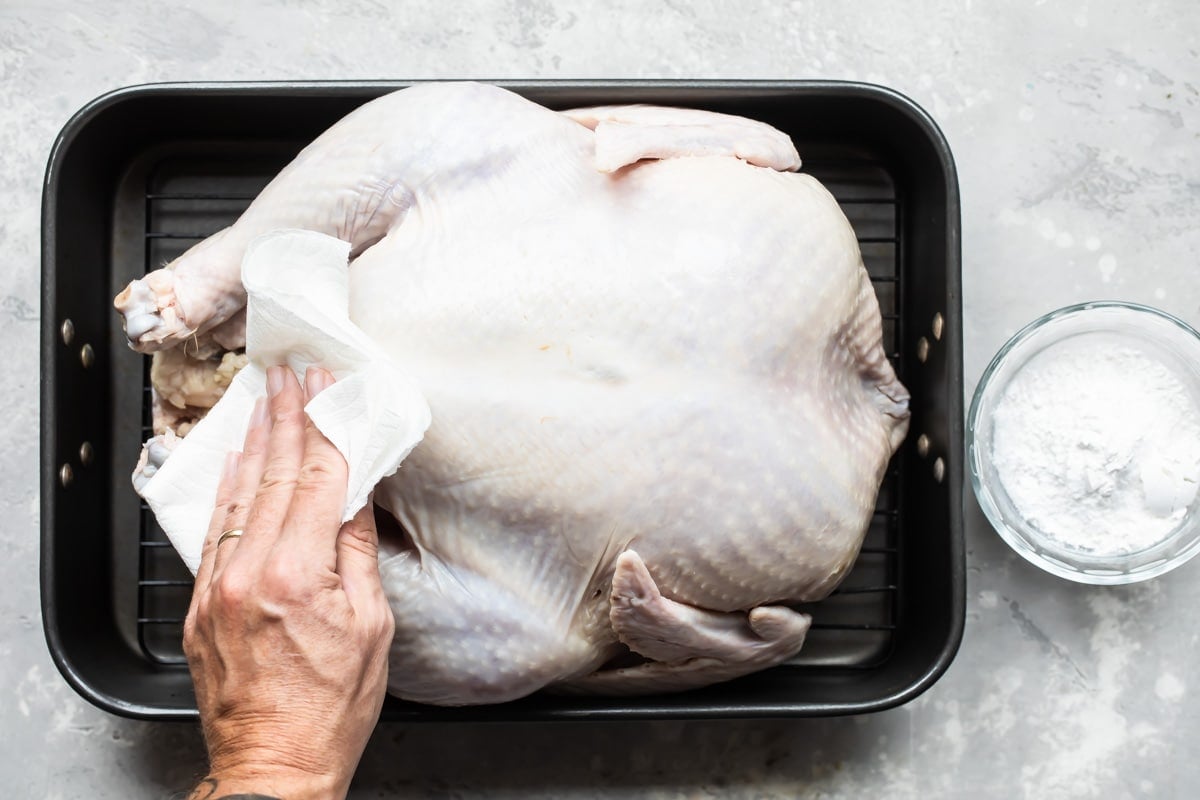
- In a small bowl, combine the kosher salt and baking powder. Sprinkle the salt mixture over the bird, from about 6 to 8-inches away. Coat well, stopping before a crust forms. (All of the salt mixture may not be needed.) Transfer the turkey to a rimmed baking sheet and refrigerate, uncovered, about 12 to 24 hours.
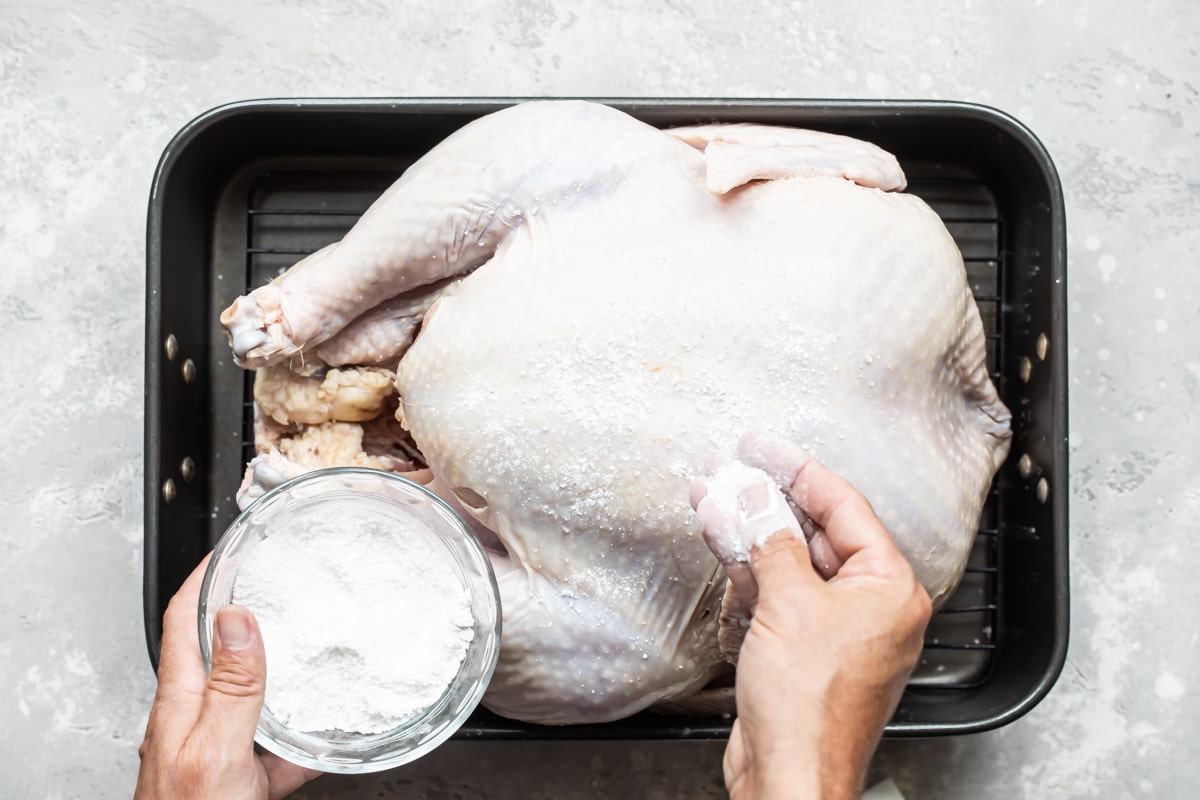
- Remove the turkey from the refrigerator and let sit at room temperature 2 hours. You are now ready to truss the turkey for roasting.
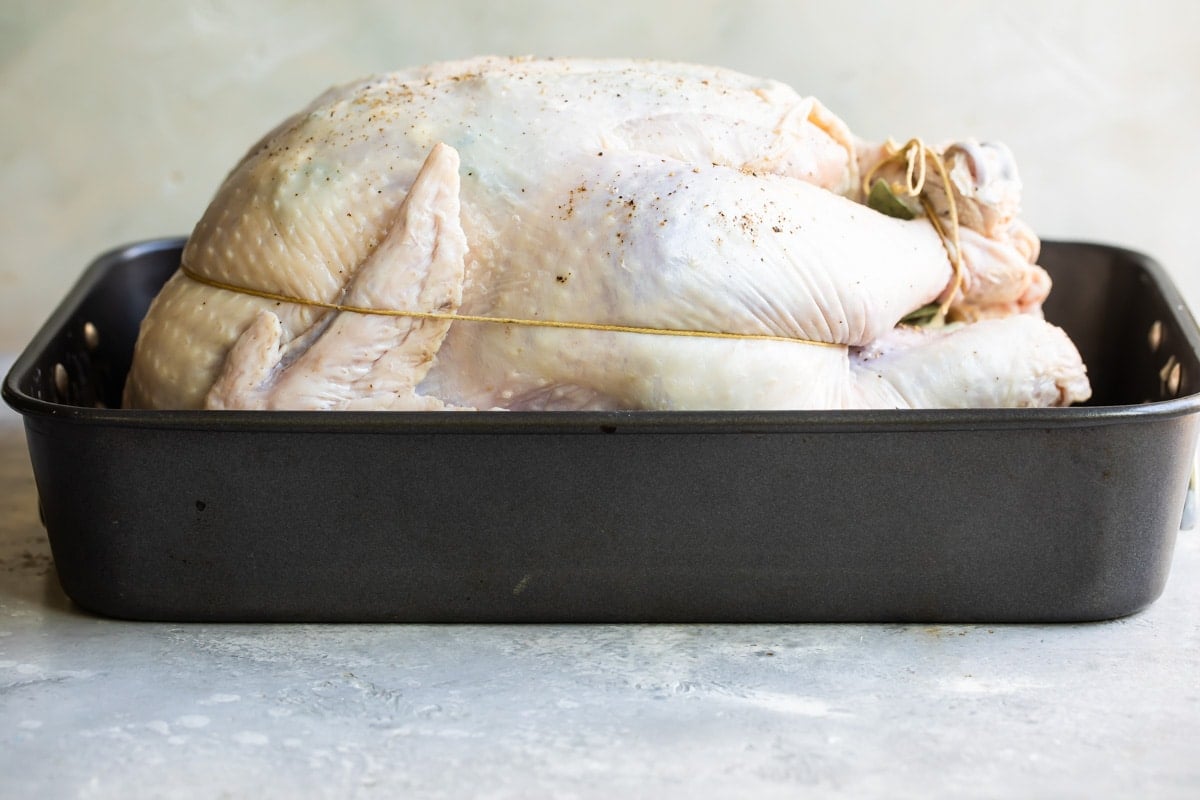
Recipe tips and variations
- Yield: The recipe as written will brine one turkey weighing 12 to 16 pounds.
- Storage: If you want to brine the turkey for more than 24 hours, cover it loosely with foil or a plastic bag.
- Use a pan to catch any drips: A roasting pan or rimmed baking sheet keeps drips to a minimum.
- Dried herbs: If you like, add any dried herbs (oregano, thyme, rosemary) or spices (paprika, pepper, cayenne) to the dry brine to slather over the turkey.
- Ultimate Turkey Guide: Cook your best Thanksgiving menu (or Sunday dinner) ever. Brush up on how to buy, thaw, brine, and cook a turkey, plus learn how easy it is to make turkey broth from bones and turkey gravy from pan drippings.

Frequently Asked Questions
The best (safest) way to thaw a frozen turkey is slowly in the refrigerator over several days. Never thaw a turkey using warm or hot water, in the microwave, or out at room temperature. All of these methods are dangerous because they let bacteria grow before the turkey is completely thawed.
Brining a turkey is totally optional. It adds juiciness and flavor, but it’s not required.
I recommend dry bringing because it’s easier (you don’t have to use and store a giant container of water for your turkey) and more effective (the salt and/or spices are directly on the surface of the turkey and can penetrate directly instead of being diluted by water).
More turkey techniques
Working with Meat and Fish
How to Thaw a Turkey
Working with Meat and Fish
How to Truss a Turkey
Working with Meat and Fish
How to Carve a Turkey
Stock, Sauce, and Spread Recipes
How to Make Turkey Broth
Join Us
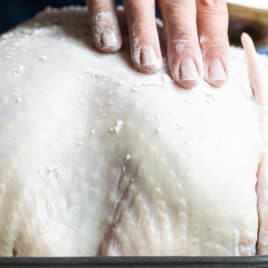
How to Brine a Turkey
Ingredients
To dry brine a turkey:
- 1 (14 pound) fresh turkey neck, heart, and gizzards removed and discarded (see note 1)
- 1/2 cup kosher salt (see note 2)
- 2 tablespoons baking powder (see note 3)
To wet brine a turkey:
- 3 cups kosher salt
- 1/2 cup granulated sugar
- 1 yellow onion chopped
- 1 bunch fresh thyme
- 1 tablespoon whole black peppercorns cracked
Instructions
To dry brine the turkey:
- Under running cold water, rinse the turkey well inside and out. Remove any excess fat or pin feathers. Pat dry using paper towels.
- In a small bowl, combine the kosher salt and baking powder. Sprinkle the salt mixture over the bird, from about 6 to 8-inches away. Coat well, stopping before a crust forms. (All of the salt mixture may not be needed.) Transfer the turkey to a rimmed baking sheet and refrigerate, uncovered, about 12 to 24 hours.
To wet brine the turkey:
- In a pot large enough to hold the turkey and fit in the refrigerator, add cold water to fill pot ⅓ full.
- Add 3 cups kosher salt, ½ cup sugar, 1 chopped yellow onion, 1 bunch fresh thyme, and 1 tablespoon fresh cracked peppercorns.
- Place the turkey into the pot, breast-side down. Add additional cold water to completely cover the turkey and fill the pot as much as possible
- Cover with the lid and place in the refrigerator for 24 hours. Remove the turkey from the refrigerator 2 hours prior to roasting. Discard the brine, and under cold water, rinse the turkey inside and out. Pat dry with paper towels.
- Place back into the stock pot and cover with cold water. Allow to sit at room temperature. Proceed with steps to truss and roast the turkey.
Recipe Video
Notes
- Turkey: Look for a natural or heritage turkey with the words “no salt added” on the label. Stay away from “self-basting” or Kosher turkeys which are injected with a salt solution. Brining an already salted turkey will make the bird way too salty. How much turkey per person? Plan on 1 1/4- 1 ½ pounds for each eater.
- Kosher salt: Kosher salt is iodine-free with a coarse texture ideal for rubbing on meat (Morton’s and Diamond Crystal are good brands). Don’t substitute standard table salt here; it’s finer and saltier than kosher.
- Baking powder: Baking powder dries out the outer layer of the turkey resulting in deliciously crispy skin.
- Yield: The recipe as written will brine one turkey weighing 12 to 16 pounds.
- Storage: If you want to brine the turkey for more than 24 hours, cover it loosely with foil or a plastic bag.
- Thawing a turkey: The best (safest) way to thaw a frozen turkey is slowly in the refrigerator over several days. Never thaw a turkey using warm or hot water, in the microwave, or out at room temperature. All of these methods are dangerous because they let bacteria grow before the turkey is completely thawed.
- Use a pan to catch any drips: A roasting pan or rimmed baking sheet keep drips to a minimum.
- Dried herbs: If you like, add any dried herbs (oregano, thyme, rosemary) or spices (paprika, pepper, cayenne) to the dry brine to slather over the turkey.
Nutrition
Meggan Hill is a classically-trained chef and professional writer. Her meticulously-tested recipes and detailed tutorials bring confidence and success to home cooks everywhere. Meggan has been featured on NPR, HuffPost, FoxNews, LA Times, and more.
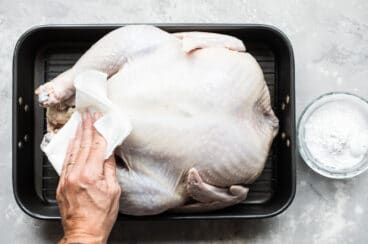
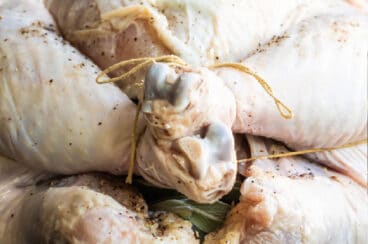
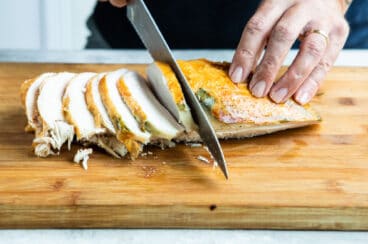
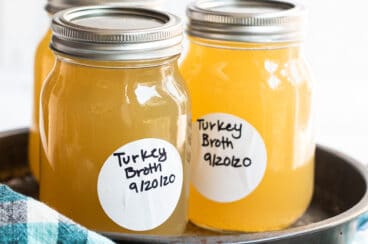
After dry brining my turkey for 24 hours do I rinse off the bird before putting in the oven?
Hi Don, no you do not. Happy Thanksgiving! – Meggan
Hi,
I get what you are saying about Turkey & I know you can do same with chicken.
We, are two so will probably have duck.
I’m confused about whether we can improve duck meat. Looking on Google gives a mass of consumercentric info
Better to ask an expert. So, can I, should I Brine my duck (& how). Keep safe & vote
Thabks
Paul.
Hi Paul, great question. I haven’t tried brining duck, but I don’t see why you couldn’t. Sorry about that – Meggan